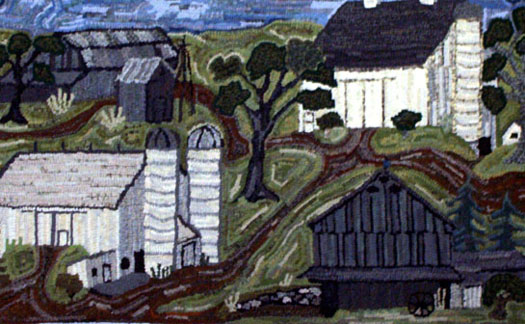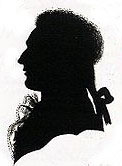What’s Up at Wassenberg 2/16/11

Hooked rugs and quilts featured in Art of Fiber exhibit
By now I hope that many of you have visited the Wassenberg Art Center’s “Art of Fiber” exhibit. This is a popular show and has attracted people from all around the Van Wert area and beyond.
The display includes quilts from the collection of Barb Pemberton and hooked rugs by members of the Black Swamp Rug Hookers. This week I’d like to give you some information about the rugs. Actually, there are more than rugs on display; the rug hooking group also makes felted purses, needlepunch work, chair covers, and more.
Many of the rugs on display were designed by their makers. “Family Barns” by Altha Brooks is a good example. The rug features the barns her family grew up with: a gambrel roof barn in Putnam County from her father-in-law’s farm; a three level bank barn near Columbus on the farm where Altha was raised; a bank barn near Bluffton on the farm where her husband grew up, and the bank barn on the farm where Altha’s mother-in-law was raised, near Bluffton.
Several of the rugs in this display have this kind of personal connection to their makers.
Much of the charm of hooked rugs comes from the colors chosen by the artists which range from muted, earthy tones to bright colors. The pictures on the rugs are charming — some rugs have folk art themes, others, like the “Family Barns” rug, depict realistic objects or scenes.
The exhibit continues through February 25, 1-5 p.m. Tuesday through Sunday (closed Mondays), and admission is free. The show is sponsored by 1st Federal Savings & Loan and Stephanie Dawn.
The Wassenberg Art Center is located at 643 S. Washington Street in Van Wert, Ohio. Contact us by phone at 419.238.6837 or e-mail wassenberg@embarqmail.com. Information about coming events can be found on our website at www.vanwert.com/wassenberg.
The ancient art of silhouette
If you have ever used your hands and a flashlight to make shadows that look like animals or faces, you have practiced the art of silhouette (sil-a-WET). A silhouette is the image of a person, object or scene consisting of an outline

with a featureless interior.
Silhouettes have an ancient history. No one knows when the first person got the idea of tracing a line around a human shadow. There is a story by Pliny the Elder (circa 77-79 AD) about a potter named Butades whose daughter was deeply in love with a young man. Before her lover left for a long journey, the girl traced his profile as it was thrown upon the wall by the light of a lamp. Her father saw the likeness on the wall and pressed clay inside the outline to create a face in relief, which he then fired in his kiln. If the story is true, this may have been the first use of the silhouette as an art form.
For hundreds of years in both Europe and America, profiles cut from black card paper were the cheapest way of recording a person’s appearance. The art got its name in 1759 when a gentleman named Etienne de Silhouette was a French finance minister. During the Seven Years War, France’s financial problems forced Silhouette to impose severe economic restraints on the French people — particularly the wealthy. The noblemen looked for a way to ridicule him. Because he enjoyed making cut paper portraits, Silhouette’s name came to refer both to these “empty” portraits and to anything that was done very cheaply.
The term “silhouette” now includes not only profile portraits but also intricate pictures of people, animals, plants and landscapes. It can also refer to anything with a silhouette appearance, such as a figure standing against a bright light.
Silhouettes can be painted or drawn, but the traditional method is to cut them from lightweight black cardstock which is then mounted on a light (usually white) background. For many years silhouette artists worked out of booths at fairs or markets. These experts could cut the likeness of a person, freehand, within just a few minutes. Some silhouette artists became famous, such as S. John Ross of Australia, who cut silhouettes at agricultural shows for 60 years until he died in 2008.
Silhouettes were used as book illustrations during the early 20th century. Illustrations on color plates were expensive to produce and each one had to be glued into the book by hand. Silhouettes printed with blocks were cheaper to produce and easier to print. Therefore silhouettes were often used in conjunction with color plates to add to the books’ visual appeal. Among famous illustrators who produced silhouette pictures at this time were Arthur Rackham and W. Heath Robinson.
Although the invention of the camera ended the widespread use of silhouettes as portraiture, the skill wasn’t lost. Traveling silhouette artists often appear at fairs and festivals, and silhouette artists advertise their services on the internet for weddings and other occasions. People are rediscovering the silhouette for fine art, book illustrations, greeting card designs, and nostalgic portraits.
The silhouette is found in unusual places. In Hawaii, for example, quilters sometimes lay fabric under the tropical foliage and trace the shadows cast by the leaves, to create beautiful quilt patterns. Silhouettes are used on signs to identify all sorts of things — for example, restrooms and handicapped parking spaces.
To cut a simple silhouette portrait, you’ll need a strong light source (such as a gooseneck lamp or other light that will project light on a targeted area), white colored pencil, black construction paper, and a very sharp pair of scissors that will make accurate cuts (good embroidery scissors work well). Use masking tape to fasten the construction paper to the wall. Darken the room and turn on the strong light. Seat your subject between the paper and the light source so the shadow of the person’s profile falls sharply on the paper. The shadow must be sharp and details of the profile should show clearly.
Make sure your subject holds still. Use the white colored pencil to draw the outline of his/her shadow on the black paper. Once you’ve drawn the complete outline, take the paper off the wall and carefully cut along the white line to create your silhouette. Mount the black profile on white paper and frame it.
POSTED: 02/16/11 at 2:27 pm. FILED UNDER: What's Up at Wassenberg?







